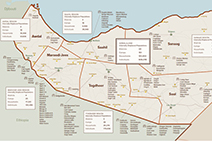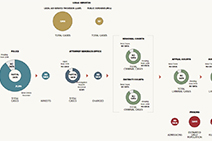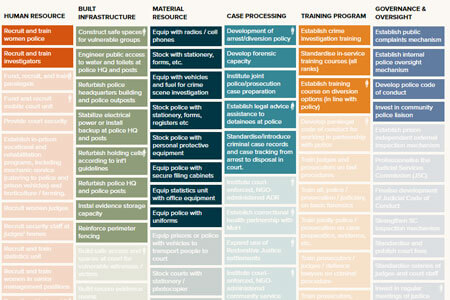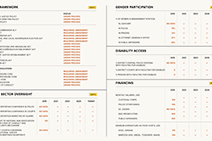Justice Snapshot Somaliland
JUSTICE SNAPSHOT SOMALILAND 2021
“Complete, accurate and reliable statistics are an absolute requirement for efficient public action. Statistics inform decision makers and the broader community with critical information on the needs of the population and specific challenges they face. Quality data can reveal where resources are most needed, and provide the means to track progress and assess the impact of different plans and policies. Somaliland, as is the case in many other developing countries, still lacks the capacity to regularly produce the full range and quality of statistics typically required to effectively design, implement and monitor the relevant policies and plans needed for the country’s development.” (Ministry of Planning and National Development, Central Statistics Dept., Somaliland In Figures 2019).
THE JUSTICE SNAPSHOT
The Justice Snapshot Somaliland aims to support institutional and national capacity to capture data on the criminal justice system as it functioned in the six regions of Somaliland in the year ending 31 December 2019.
This is a collaborative product of government, justice actors/practitioners, court users, implementing and development partners. It applies and adapts the Justice Audit methodology used in Malaysia and Bangladesh previously (see Methodology). It draws from lessons learned in the Justice Snapshot South Central Somalia 2020.
Notwithstanding the COVID pandemic, from deployment of trained researchers under Transparency Solution to the validation of the data by the Justice Snapshot Steering Committee (JSSC) took less than 3 months. This efficiency is attributable in great part to the active support of government, the institutions concerned and their representatives in the Justice Snapshot Steering Committee (‘JSSC’) which oversee the process of data collection.
A process to improve data collection and inform policy making…
This Justice Snapshot is intended as the start of a process that sees government and justice institutions investing more in their own data. The data belong to the government and institutions concerned. The Justice Snapshot team sought the permission of each institution to collect and publish their data. All but the Supreme Court consented. The data presented here were formally validated by the JSSC. Court data were not validated by the Supreme Court and the data on infrastructure, resources & governance captured here from the courts were assembled from data in the public domain: there were no case management figures for 2019 and the Annual Report of the SC for that year is expected at the time of writing (April 2021). The website is updateable and the intention is that an information management unit will be established to capture data going forward. The visuals will automatically reconfigure to reflect the new data.
…providing an agreed set of data all can plan around
The web application is in Somali/English translations (toggle top right of each page) and is divided into a number of sections.
The Situational Overview provides the context in which statutory justice services function – and the budgetary allocations available to them.
Justice Services show the resources and infrastructure in terms of justice services available to ordinary people and provide overviews of: i) the number of cases that went through the justice system in 2019; and ii) governance and training issues viewed nationally.
The Key Measures are drawn from policy documents (such as the NDP II and institutional strategic plans, as well as data relevant to the Sustainable Development Goals – SDGs) and are advanced as possible benchmarks against which to monitor progress nationally and by region. They start in 2019 (the year most data are gathered) and can be updated at intervals (two years are suggested here). The ‘Target’ is deliberately left open for decision makers to determine their own.
The Opportunity Analysis sets out a number of Justice Investment Options indicated by the data and institutional strategic plans and priorities. The options are advanced for consideration and are not exhaustive. They are suggested by the data gathered and gaps they reveal. The Investment Options can be viewed in different combinations to provide menus of supporting activities (>Filter by the categories listed on the left and click on a combination of several). They might be seen as a set of ingredients to inform planners, programmers and institutional decision makers in designing a programme, plotting an intervention or embarking on a series of reforms. At the bottom on the left, by clicking >Filtered results: show detail, actions can be prioritised and their sequencing more easily clarified.
After Acknowledgements and Methodology, the Baseline Data contain all the data collected and cleaned, and validated by the JSSC in excel format. The data contained in any visualisation can be cross-checked here. The Library is a repository of all documentation relevant to the justice sector, including the laws (in Somali and English).
A working tool rather than stand alone report
The Justice Snapshot should be used as a tool to follow a particular line of enquiry, rather than as a report to read through section by section.
Navigating tip 1: Click, click, click
Start with a question and then follow the line of questioning, or pick a strand and see where it leads. Click on the icon at the top of each page for Comment or Data Note. These will explain what the viewer is looking at as well as the sources of data relied on.
Navigating tip 2: Filter the Investment Options
The Opportunity Analysis and the Justice Investment Options provide many options. The viewer will want to filter them so may click on
>Built Infrastructure – and filter this by
>Court.
Further filtering enables the viewer to view these options from the point of view of the most marginalised and vulnerable groups by adding
>Human Rights
And so on.
Navigating tip 3: Data do not / will not always add up
None of the institutions is required to report with the degree of rigour and disaggregation set out here. In some places, there were no Registers or Ledgers, in others the administrators had no training on what or how to administer. In places, the data did not exist (for instance, cases disaggregated by gender or age); while in others it was volunteered in interview and unsubstantiated from records. The data are provided in good faith, there will be error and these errors are identified or indicated where they are apparent. Are they 100% accurate? No, but few countries can boast this. Are they the best available? Probably yes. It is worth recalling that this exercise marks the beginning of a process to improve data collection locally which will inform policy making nationally.



